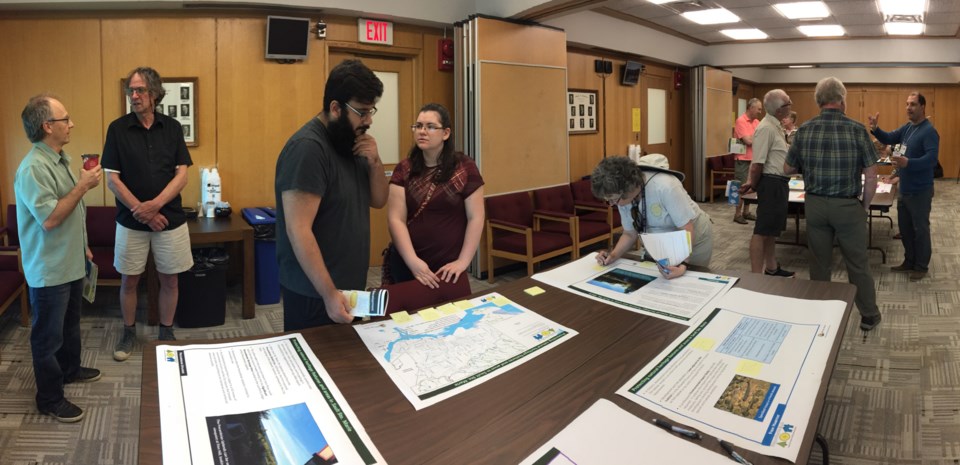More trees, please?
The City of Sault Ste. Marie is starting to frame up a policy to safeguard our urban forest canopy.
One year ago, the Ontario government announced that by March 1, 2019, all municipalities must have policies setting out "the manner in which the municipality will protect and enhance the tree canopy and natural vegetation in the municipality.”
Should we also develop a local tree-cutting bylaw limiting the ability of landowners to remove trees on their own property?
The issue was raised at Tuesday night's Shape the Sault open house on the natural environment and natural resources.
It was the evening's most-discussed question.
"Municipalities are allowed to pass tree bylaws to prohibit or regulate destruction or injuring of existing trees," said an information sheet available at the event. "Is a tree bylaw needed for Sault Ste. Marie, and if so, what should the regulations be like?"
The City of Sault Ste. Marie already has policies encouraging urban trees.
For example, our existing official plan calls for:
- maintaining and reinforcing wooded areas within or next to development sites
- maintaining existing trees
- tree planting is mandatory for new development and encouraged in existing developments
- use of trees in front and exterior yards and as visual screens for outdoor storage, service and parking areas
Seven years ago, City Council approved sustainable site plan guidelines for commercial and institutional developments including:
- using a combination of shade trees, shrubs and permeable landscaped areas to help reduce urban heat, creating a more comfortable microclimate
- parking lots within new developments must have one shade tree for every 12 parking spaces, planted in a manner that maximizes shading of the parking surface
- if more than 10 trees are required, no more than 50 per cent may be of the same type
- the city encourages the use of native species wherever possible
Kara Flannigan, Green Party candidate in the recent provincial election, believes we also need a tree protection bylaw.
"I'm a tree-hugger, literally," Flannigan tells SooToday.
"A tree gives us oxygen, dust control, there's all kinds of advantages with trees. In my opinion, we can't have enough of them."
300-year-old tree
"There are so many ancient trees," Flannigan told us at the Shape the Sault event.
"I went on one of the Jane's Walks and we saw a tree that was over 300-years-old. Those need to be protected for heritage reasons.""As well, if you look at the massive red pines that are out at Pointe aux Pars, that forest is spectacular. Where do you see anything like that?" Flannigan said.
Flannigan is also a proponent of afforestation – planting trees in places where they have never grown before or haven't grown for a long time.
In Japan, for example, compatible trees are placed in planter boxes to create miniature urban forests.
This, Flannigan says, is "better for our brains and our mental health."
"I also want us to actively replace lawns with little forests, in pockets around our city," she said.
"We can change our climate. We can be a little more resilient."
Wallace Terrace
"If you look at all of the solar-panel farms, Why aren't we growing milkweed in there? It won't block the solar panels, but it provides food for the monarch butterflies."
"What about all along Wallace Terrace there? Planting trees to hide that fence. It helps with noise control and dust control. Visually, it makes things a lot more pleasant."
Flannigan also called for planting indigenous flora in the Sault's flood-control channels, an idea also proposed in materials prepared by city planners for Tuesday's open house.
"Naturalizing flood channels in the west end could make them more habitable for local birds, and potentially also enable the channels for recreational use," said one poster prepared by city planning staff.
"The main reason for the flood channel is to whisk water away quickly during rain events," Peter Tonazzo, senior city planner, told SooToday.
But cement-and-grass-banked flood channels can also function as park space and natural habitat.
"At the end of the day, that's a discussion that's worth having and we need to have it," Tonazzo said, emphasizing that any such measures should not impede the main flood-control purpose of the waterways.
Urban-rural issues
Tuesday night's open house was the second major event of the Shape the Sault series, intended to update our official plan and develop a new long-term vision for the city.
The first event, focusing on urban-rural issues, took place on March 27 at R. M. Moore School at 1272 Base Line.
Ideas floated at the earlier event included allowing local farmers to generate additional revenues through non-agricultural activities on active farms, such as woodworking, contractor's yards and public storage.
The March open house also raised questions about local aggregate operations, where provincial policies allow only limited residential development.
"Rural areas also have substantial volume of sand and gravel deposits, which could see increased market demand in the future," said a poster displayed at the March event.
"Gravel pits and quarries require large tracts of land and adequate separation from nearby sensitive land uses, such as residential uses. Therefore, not only would each residential severance reduce the overall size of a parcel, but the creation of a new sensitive land use would impact the ability for gravel pits to open or expand," the poster said.
